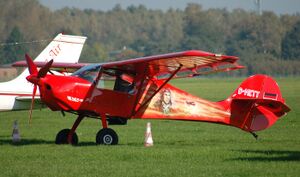Avid Flyer
Topic: Engineering
 From HandWiki - Reading time: 4 min
From HandWiki - Reading time: 4 min
| Flyer | |
|---|---|

| |
| Avid Flyer Mk.IV | |
| Role | Two seat homebuilt aircraft |
| National origin | United States |
| Manufacturer | Light Aero |
| Designer | Dean Wilson |
| First flight | 1983 |
| Number built | 2,000+ (Avid Flyer + Avid Magnum) kits by 2001[1] |
| Developed into | Avid Champion Avid Catalina Airdale Backcountry |
The Avid Flyer is a family of United States single engine, high-wing, strut-braced, conventional landing gear-equipped, two seat ultralight[citation needed] aircraft designed for kit construction in the 1980s. Its several variants sold in large numbers. In 1987 a Flyer became the first ultralight to land at the North Pole.[citation needed]
Design and development
The kitbuilt two seat lightplane was designed by Dean Wilson in 1983, the first prototype flying in 1983 and appearing at Oshkosh that year. Kits were produced by Light Aero with several names (Bandit, Lite, Magnum and Mk.IV) with many options including two wing designs, the choice of tricycle, tailwheel, ski or float undercarriages, rescue parachutes and a variety of engines. Lite Aero production continued until the company went bankrupt in 1998. Avid Aircraft reappeared in 2003, but by 2010 the kits, including new variants, and components were produced by Airdale Flyer.[2][3]
The Avid Flyer is a conventional layout, single engine, side by side two seat light aircraft, with a strut-braced high wing configuration. Aluminum tubes serve as leading edge/main spar and rear spar, each wing being supported by a pair of tubular lift struts. Sawn plywood wing ribs are bonded to the aluminum tube spars using a filled epoxy compound. The Avid Flyer features Junkers style one-piece flaperons supported by three offset hinge arms. The Junkers design moves the control surfaces well underneath the wing, where they remain in undisturbed smooth airflow at low speed and/or higher climb angles.[citation needed]
The welded steel tube fuselage is flat sided, narrowing towards a braced cruciform tail group. The horizontal tailplane is carried on the fin just above the upper fuselage line. The aircraft's conventional rudder and elevator controls are cable operated.[citation needed]
Wilson's original intent developing the Avid Flyer was to offer an economical home-built aircraft to bridge the gap between conventional aircraft of the "Piper Cub" / "Taylorcraft" / "Aeronca" category and the minimalist ultralight aircraft such as the "Quicksilver" that had not yet matured into acceptable levels of reliability and safety in the early 1980s. The ability to fly from short, unimproved, and back-country strips was also one of Wilson's design priorities. Due to its light weight, good power-to-weight ratio, and design features such as the Junkers flaperons, the Avid Flyer excels in this type of environment and STOL operations. Recent developments in small aircraft engine design and reliability have brought the Avid Flyer well into the realm of being seen as a highly capable and economically viable choice for light sport use.[citation needed]
Operational history
By about 2008, some 2,000 Flyer kits had been built over five continents.[2] 346 Flyers and Magnums appear on the European (excluding Russian) civil registers.[4] Perhaps the most remarkable flight was that made by Hubert de Chevigny in an Avid Lite 532 equipped with an additional 300 L (66 Imp gal, 79 US gal) fuel tank. Accompanied by Nicholas Hulot in an Aviasud Mistral, he left from Resolute, Canada on 2 April 1987, reaching the North Pole on 7 May in three stages. They were the first ultralights to do so.[2][5]
Variants
- Flyer
- Early versions with straight trailing edge rudder, foldable wings and either 45 hp (30 kW) Cayuna or 65 hp (49 kW) Rotax 532 engines.
- Mk IV
- Fuller, curved edge rudder and either a 64 hp (48 kW) Rotax 582 or a Rotax 912 engines. Baggage compartment added. Introduced 1992. The Mark IV was further developed into the Airdale Backcountry.[6][7]
- Bandit
- Economy version with 50 hp (37 kW) Rotax 503.[8]
- Magnum
- Heavier, powered by a 160 hp (119 kW) Lycoming O-320 or an engine in the 125 hp (93 kW) to 180 hp (134 kW) range.
Specifications (Mk IV STOL)
Data from Simpson 2001[1]
General characteristics
- Crew: one
- Capacity: one passenger
- Length: 17 ft 11 in (5.46 m)
- Wingspan: 29 ft 10 in (9.09 m)
- Height: 6 ft 1 in (1.85 m)
- Empty weight: 511 lb (232 kg)
- Max takeoff weight: 1,151 lb (522 kg)
- Powerplant: 1 × Rotax 582 two cylinder two stroke, water cooled, 65 hp (48 kW)
- Propellers: 2 blade-bladed
Performance
- Maximum speed: 105 mph (169 km/h, 91 kn)
- Cruise speed: 92 mph (148 km/h, 80 kn)
- Stall speed: 32 mph (51 km/h, 28 kn)
- Range: 340 mi (550 km, 300 nmi)
- Service ceiling: 16,000 ft (4,900 m)
- Rate of climb: 1,000 ft/min (5.1 m/s) initial
- Maximum climb angle: 45°[citation needed]
See also
Related development
- Denney Kitfox
- Flying K Sky Raider
- Rocky Mountain Wings Ridge Runner
References
- ↑ 1.0 1.1 Simpson, Rod (2001). Airlife's World Aircraft. Shrewsbury: Airlife Publishing Ltd. pp. 64–5. ISBN 1-84037-115-3.
- ↑ 2.0 2.1 2.2 Perrier, Patrick (2010). Fox-Papa Les avions de construction amateur. Rennes: Marines Edition. pp. 48–9. ISBN 978-2-35743-048-8.
- ↑ "Airdale sportplane and supply". http://airdale.com/.
- ↑ Partington, Dave (2010). European registers handbook 2010. Air Britain (Historians) Ltd. ISBN 978-0-85130-425-0.
- ↑ "20 April - 7 May 1987, North Pole". http://www.flymicro.com/records/index.cfm?record=remarkable_feats.
- ↑ Bayerl, Robby; Berkemeier, Martin (2011). "World Directory of Leisure Aviation 2011-12". World Directory of Light Aviation (Lancaster UK: WDLA UK): 92. ISSN 1368-485X.
- ↑ Vandermeullen, Richard: 2012 Kit Aircraft Buyer's Guide, Kitplanes, Volume 28, Number 12, December 2011, page 38. Belvoir Publications. ISSN 0891-1851
- ↑ Purdy, Don: AeroCrafter - Homebuilt Aircraft Sourcebook, Fifth Edition, page 120. BAI Communications, 15 July 1998. ISBN:0-9636409-4-1
 |
 KSF
KSF
